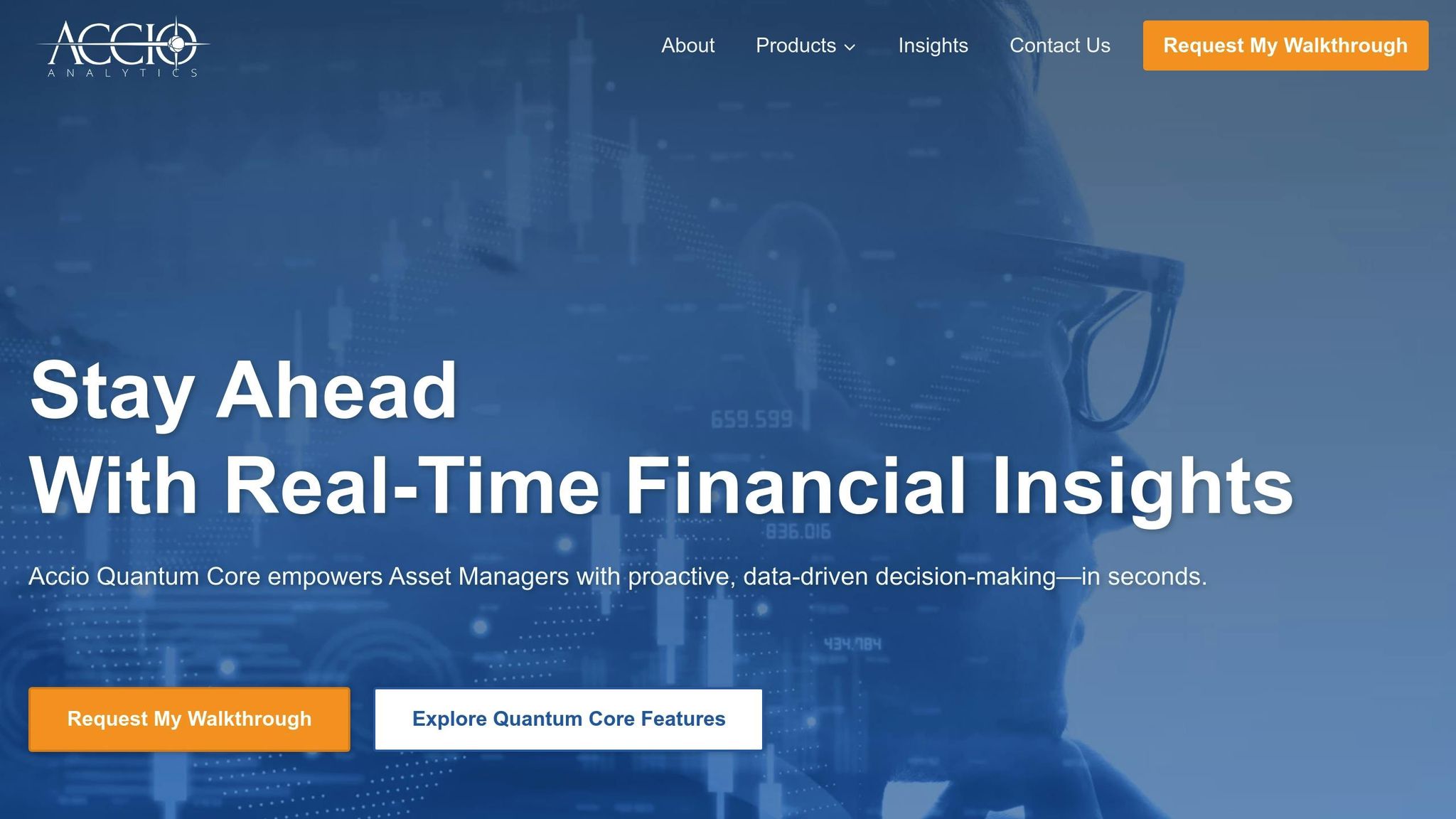Escaping the Monolith: The Strategic Flaw of Costly, Inflexible Financial Systems
Accio Analytics Inc.
15 min read
Legacy financial systems are more than just outdated – they’re actively holding your firm back. These monolithic platforms drain IT budgets, slow decision-making, and make adapting to market changes a painfully slow process. If your team is stuck dealing with overnight processing delays or struggling to integrate new tools, you’re not just losing time – you’re losing competitive ground.
Here’s the bottom line: Modern, modular systems offer a smarter way forward. By replacing rigid, all-in-one platforms with flexible, API-driven solutions, firms can cut costs, improve operational efficiency, and make decisions in real time. Tools like Accio Quantum Core allow you to upgrade incrementally, keeping disruptions minimal while delivering immediate results.
Key Takeaways:
- Cost Savings: Legacy systems eat up IT budgets, leaving little room for innovation. Modular solutions reduce maintenance costs and eliminate manual processes.
- Real-Time Insights: Stop relying on outdated data. Modern platforms provide live portfolio updates, enabling faster, more informed decisions.
- Scalability Without Overhauls: Modular systems grow with your business, avoiding the need for expensive infrastructure upgrades.
- Improved Risk Management: Real-time monitoring and automated compliance processes reduce errors and regulatory risks.
The choice is clear: Modernizing now ensures your firm stays competitive. Waiting too long risks being forced into costly, disruptive changes later. This guide provides both the strategic rationale and technical roadmap to leave legacy systems behind and move toward a more agile, efficient future.
Problems with Costly, Inflexible Financial Systems
Legacy systems bring more than just high maintenance bills – they create ripple effects that touch every corner of a firm’s operations. From financial strain to sluggish adaptability, these outdated systems can undermine a company’s standing in a competitive market.
The Financial Strain of Legacy Systems
Keeping older financial systems running isn’t just a drain on IT budgets – it’s a roadblock to growth. Maintenance costs pile up, leaving fewer resources for innovation or strategic upgrades. And when these systems can’t keep up with evolving requirements, firms are forced to lean on manual processes. This not only slows down operations but also introduces a higher risk of errors.
Take regulatory compliance as an example. Older systems often require manual reporting and documentation, which eats up time and resources. The result? A cycle of inefficiency that compounds the financial burden and stifles agility.
Inflexibility Slows Market Adaptation
In today’s fast-paced financial environment, slow systems are a liability. Legacy platforms often operate on rigid schedules, making timely access to data a challenge. This lag can prevent firms from responding quickly to market shifts or meeting investor demands for real-time updates and tailored reporting.
When innovation takes a back seat to outdated technology, firms risk being outpaced by competitors who can adapt more swiftly.
Security and Compliance Challenges
The risks don’t stop at inefficiency. Legacy systems are often vulnerable to security breaches and compliance failures. Outdated security measures and fragmented data management practices leave firms exposed to cyber threats. And without real-time monitoring, compliance gaps can go unnoticed, increasing the likelihood of regulatory issues.
Audits, too, become a headache. Delays in identifying and addressing compliance problems can extend the time and effort required for thorough reviews. To make matters worse, reliance on aging technology often ties firms to specific vendors. If these vendors stop offering support or face disruptions, companies may be forced into rushed – and expensive – system migrations, risking data integrity and operational stability in the process.
How to Evaluate Technology Problems
Before moving away from legacy systems, it’s essential to get a clear understanding of how your current technology is performing. A thorough evaluation uncovers not just surface-level issues but also deeper inefficiencies that may be draining resources and holding back growth.
Identifying System Issues
Start by pinpointing pain points across your operations. For example, look at how long it takes to generate reports and how much time is spent manually consolidating data. These delays can reveal inefficiencies that impact overall productivity.
Integration challenges are another warning sign. If your team frequently resorts to manual data transfers because systems don’t communicate well, document these instances. Similarly, note when system limitations lead to costly workarounds or slow down critical projects.
Pay attention to IT maintenance costs, too. If your technology budget keeps climbing without noticeable improvements in functionality, it’s likely your legacy systems are consuming resources that could be better spent elsewhere.
User feedback is also a valuable tool. Survey your teams about the challenges they face with daily tasks. If employees spend more time fixing system issues than focusing on their core responsibilities, productivity suffers, and the financial impact can be significant. Backing these insights with metrics makes the case for modernization even stronger.
Measuring Performance with Data
Once you’ve identified the issues, it’s time to quantify them. Start by calculating the cost per transaction – whether it’s processing trades, generating reports, or handling compliance checks. Modern systems often lower these costs through automation and improved efficiency.
Track system downtime, both planned and unplanned. Frequent outages or long downtimes are clear indicators that your technology is outdated. Similarly, monitor error rates in data reconciliation and reporting; high error rates often point to risks tied to manual processes.
Assess reporting delays by measuring how long it takes to access portfolio performance data after market close. Legacy systems often require lengthy processes to compile reports, whereas modern platforms can deliver insights almost instantly.
Another key metric is data processing speed. Time how long it takes to run portfolio optimization scenarios or stress tests. If these processes take too long, you could be missing opportunities to respond to market changes more effectively.
Comparing Legacy and Modern Systems
Structured comparisons can help stakeholders see the true cost of sticking with outdated technology. Start by evaluating the total cost of ownership, which includes maintenance, manual processing, opportunity costs, and compliance risks.
Performance benchmarks are also critical. Compare processing speed, data accuracy, and system availability. Modern systems typically handle calculations faster and more accurately, thanks to automated validation.
Scalability is another factor. Determine whether your current system can handle an increase in assets under management without requiring costly infrastructure upgrades. Modern platforms are often modular and can scale dynamically, avoiding the need for expensive hardware investments.
Compliance is a growing concern, so assess how quickly your system adapts to new reporting requirements. While legacy systems may require extensive updates, modern platforms are often designed to handle regulatory changes more efficiently.
Finally, consider integration capabilities. Compare the connectivity options of your current system with those of modern platforms, which often come with pre-built connections to a wide range of tools and data sources. This flexibility makes it easier to adopt new technologies as your business evolves.
Don’t overlook user productivity. Evaluate how well your system supports portfolio managers by considering training time for new users and the complexity of routine tasks. These insights lay the groundwork for transitioning to modern, modular solutions that address the limitations of legacy systems.
sbb-itb-a3bba55
Moving to Modular, AI-Driven Solutions
Identifying technology gaps is just the first step; transitioning to modular, AI-driven solutions is where the real transformation begins. This shift minimizes disruptions while delivering quick wins and setting the stage for smoother integration and faster insights.
Building Modular System Foundations
Every successful modernization effort starts with an API-first architecture. This ensures that each system component communicates seamlessly with your existing infrastructure, sparing you from expensive, disruptive overhauls.
The first step is pinpointing which modules to upgrade – often the data processing components that create bottlenecks. Each module should work independently while connecting through standardized APIs. This way, you can upgrade or replace individual components without affecting the entire system.
Incremental integration is key to maintaining business continuity. Instead of overhauling everything at once, deploy new modules alongside your current systems. This parallel approach allows you to test functionality, train teams, and validate results before fully transitioning. Users can gradually adapt to the new tools without disrupting workflows.
Modern modular systems should support multiple data formats and communication protocols to ensure compatibility with your current setup. This flexibility avoids vendor lock-in, protecting your technology investments as your business evolves.
Clear documentation and effective change management streamline the transition. Each new component should fit seamlessly into existing workflows, with straightforward guidelines to help users adapt. This preparation reduces resistance and speeds up adoption across teams.
Getting Faster Insights with Real-Time Data
Real-time data processing is a game-changer for investment decisions. Instead of waiting for overnight batch processes, portfolio managers can access up-to-the-minute positions, performance metrics, and risk exposures as markets fluctuate throughout the day.
This immediacy impacts decision-making at every level. Portfolio managers can react to market volatility within minutes, adjusting positions based on live risk assessments. Risk management teams can monitor exposures continuously, addressing potential issues before they escalate.
Real-time data also empowers leadership to act confidently during fast-moving market events. Immediate access to portfolio impacts, client exposures, and firm-wide risk metrics enables quicker, more informed responses.
Operational efficiency gets a boost as well. Continuous automated validation improves data accuracy, cutting down on manual reconciliation and reducing the risk of human error. Technical teams also benefit from real-time monitoring, which provides instant feedback on system performance and data quality. This allows for quick resolution of issues, preventing minor problems from snowballing into major disruptions.
How Accio Quantum Core Works

Accio Quantum Core exemplifies the modular approach, focusing on critical portfolio functions through specialized microservices. Each agent is designed to handle specific tasks while seamlessly integrating with existing systems.
- The Holdings Agent provides accurate, real-time portfolio positions across all asset classes, keeping portfolio managers informed throughout the trading day.
- The Transactions Agent streamlines trade settlement, position updates, and cash management in real time, ensuring smooth operations.
- Risk management is enhanced with the Risk Exposure Agent and Risk Ex-ante Agent, offering both historical analysis and forward-looking projections for proactive decision-making.
- The Returns Agent delivers live performance attribution, breaking down how individual securities and sectors contribute to overall returns. This helps portfolio managers make informed decisions on position sizing and sector allocation.
- Security Analytics consolidates data across equities, fixed income, and alternative investments, offering a unified view of market performance through a single interface.
- The Storyboards Agent simplifies complex data into executive-friendly dashboards and reports. C-suite leaders gain access to high-level summaries, risk metrics, and performance insights without needing to interpret raw data.
- Global Settings ensure consistency across all agents, standardizing calculation methodologies and market parameters to reduce errors and align team efforts.
The modular structure allows firms to implement agents based on their immediate priorities. For example, a firm needing faster reporting might start with the Holdings and Returns agents, while one focused on risk management could prioritize the Risk Exposure agents. This targeted approach maximizes resources and speeds up the return on investment.
Cost savings come from several angles. Automation reduces manual workloads, while improved data accuracy cuts down on error correction and reconciliation. The modular design ensures firms only pay for the features they need, avoiding the expense of unused functionalities.
Scalability is built into each agent. As assets under management grow or trading volumes increase, individual agents can scale independently without requiring a full infrastructure upgrade. This prevents over-provisioning and keeps technology spending efficient.
Compliance is another strong point. The platform includes built-in validation and audit trails for all data processing, simplifying regulatory reporting. Detailed records are maintained automatically, reducing the manual effort typically required for audits.
Accio Quantum Core allows firms to preserve their existing technology investments while introducing modern capabilities. Current systems can remain operational for specific tasks, while new agents are gradually implemented to prove their value. This measured approach minimizes risk while delivering immediate operational benefits.
Gaining Competitive Advantage Through Modernization
Modernizing outdated monolithic systems isn’t just about fixing inefficiencies – it’s about building a foundation for long-term success. Firms that embrace modernization can respond to market shifts faster, operate with greater efficiency, and scale without the limitations that often hinder competitors.
Cost Savings and Improved Efficiency
Legacy systems often come with hidden costs that drain resources. Think about the hours spent on manual data reconciliation, overnight batch processing, and fixing errors – tasks that delay decisions and tie up valuable staff time. Modern modular systems automate these processes, freeing teams to focus on high-value tasks like strategic analysis instead of routine data upkeep.
The financial impact is striking. Traditional systems often demand entire teams just to keep things running. These teams spend their days validating data, generating reports, and maintaining systems – leaving little room for activities like enhancing client service or making smarter investment decisions.
With targeted modernization, firms can address their most pressing issues without overhauling everything at once. For example, deploying specific agents to handle resource-heavy processes can quickly cut costs while paving the way for broader system improvements. Real-time capabilities further streamline operations, allowing decision-makers to focus on strategy rather than being bogged down by manual checks.
The results are clear: lower operational costs paired with better decision-making. This combination not only boosts profitability but also strengthens a firm’s competitive position by enabling quicker adaptation to market changes.
Agility and Scalability: A Game-Changer
In fast-moving markets, the ability to respond quickly is what separates leaders from the rest. Modern modular systems shine here. Unlike monolithic setups, these systems allow individual components to be updated, scaled, or replaced without disrupting the entire infrastructure. Whether it’s adapting to new regulations or reacting to market shifts, firms can pivot in weeks instead of months.
Scalability also becomes an advantage, not a hurdle. As assets under management grow, modular systems can scale specific components to handle increased data and processing needs. This prevents the slowdowns and inefficiencies that often plague older systems during periods of growth.
These systems also make it easier to test new strategies. Portfolio managers can try out different approaches using real-time data and analytics, all without needing to invest heavily in new infrastructure. Want to target a new client segment? Modular systems allow firms to serve them without building entirely separate platforms. This flexibility speeds up product development and innovation, turning technology into an enabler rather than a bottleneck.
Geographic expansion and regulatory compliance also become simpler. Firms can deploy localized agents to meet specific market requirements while maintaining consistency in their core operations. This reduces the complexity and cost of entering new regions or serving diverse clients.
Perhaps most importantly, modular systems allow for continuous updates. Instead of undergoing disruptive, large-scale overhauls, firms can upgrade individual components as needed. This keeps technology up to date without interrupting business operations. The result? A firm ready to seize opportunities while competitors wrestle with outdated, inflexible systems.
Strengthening Risk Management and Compliance
Modernized systems don’t just improve efficiency – they also enhance risk management and compliance, turning these areas into competitive strengths. Real-time risk monitoring and automated compliance processes ensure that potential issues are flagged and addressed proactively, reducing the need for manual intervention and cutting down on audit delays.
Consistency is a major win here. Modular systems use standardized calculation methods across all components, eliminating the errors that arise when different systems handle risk metrics differently. This consistency gives teams confidence in their data, no matter where it comes from.
Real-time capabilities take things a step further. Risk teams can model potential market movements and assess their impact on portfolios instantly. This allows for quicker hedging decisions and more precise position sizing, giving firms a proactive edge in managing risk.
Automated compliance processes further streamline operations. By addressing regulatory requirements in real time, firms can shift from reacting to compliance challenges to demonstrating their capabilities to both clients and regulators. This builds trust and credibility – especially with institutional clients who prioritize strong risk management.
In short, modernized systems provide firms with a comprehensive risk management approach. They offer visibility into exposures, tools to respond swiftly to changing conditions, and operational security that sets them apart in a competitive landscape. For firms looking to grow while maintaining reliability, these advantages are hard to ignore.
Conclusion: Why You Must Leave Monolithic Systems Behind
Monolithic systems are more than outdated – they’re holding your business back. Every day spent clinging to these systems is a day your competitors, armed with modular, AI-driven solutions, gain ground. The longer you wait, the higher the costs, the greater the risks, and the more opportunities you miss.
The good news? Modernization doesn’t have to be all-or-nothing. Solutions like Accio Quantum Core show that transformation can happen step by step, avoiding the massive disruptions that often make executives wary of change. With an API-driven, modular approach, you can tackle your biggest pain points – like overnight processing delays or a lack of real-time data – while still leveraging your existing systems.
The benefits aren’t just theoretical; they’re already being realized by forward-thinking firms. Faster decision-making, improved risk management, and turning compliance into a competitive edge are just a few of the measurable advantages. These are gains you can see and act on, not just promises on paper.
Now, think about what’s tied up in maintaining those legacy systems. How much capital could be redirected to growth initiatives? How much time could be freed for innovation? The resources locked in outdated infrastructure could fuel expansion and drive your firm forward.
But time is not on your side. The window for a gradual, controlled transition won’t stay open forever. Market demands, regulatory changes, and client expectations are evolving quickly. Wait too long, and you may face an emergency overhaul – the very kind of disruption modular solutions are designed to prevent.
Start by identifying your biggest bottlenecks. Whether it’s real-time portfolio monitoring, automated compliance, or better risk analytics, focus on the areas with the most immediate impact. A modular approach allows you to deliver quick wins while laying the groundwork for broader transformation.
The choice is clear: modernize strategically now or risk being forced into costly, reactive changes later. The firms embracing this shift today will shape the future of the industry. Those stuck in the past will struggle to keep up.
FAQs
What are the main advantages of switching from outdated financial systems to modern, modular solutions?
Transitioning to modular, API-driven financial systems brings a host of benefits, including increased flexibility, quicker innovation cycles, and reduced costs. These systems empower financial institutions to respond to market shifts swiftly, enabling the launch of new features and services in a matter of weeks instead of years.
By leveraging real-time data processing and automation, these platforms streamline routine tasks, cutting down operational expenses and minimizing the risk of human error. On top of that, they come equipped with advanced security measures, offering stronger safeguards for sensitive financial information. Embracing this modern approach helps organizations remain competitive, operate more efficiently, and secure their place in an industry that’s constantly evolving.
What steps can firms take to modernize financial systems without disrupting daily operations?
To modernize financial systems effectively, firms need to begin by assessing their current infrastructure. This helps identify inefficiencies and areas that require upgrades. Instead of a complete overhaul, a phased implementation is often the smarter route. Gradually replacing outdated components with modular, adaptable solutions ensures they integrate smoothly with existing systems.
Equally important is maintaining clear communication and implementing well-thought-out change management strategies. Employees should be trained on new tools and workflows to ease the transition and reduce resistance. With careful planning and a focus on scalability, firms can upgrade their systems while keeping operations running smoothly and avoiding major disruptions.
How does real-time data processing improve decision-making and risk management for financial firms?
Real-time data processing allows financial firms to act quickly and intelligently by analyzing transactions and market trends the moment they occur. This kind of instant insight is invaluable for spotting anomalies, detecting fraud, and identifying risks as they emerge.
With continuous monitoring, firms can stay ahead of potential problems, respond rapidly to shifting market conditions, and reduce losses. This approach not only improves day-to-day operations but also strengthens risk management in today’s fast-moving financial world.




